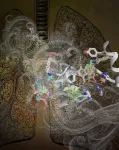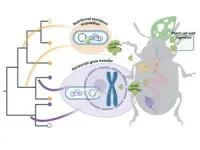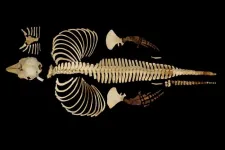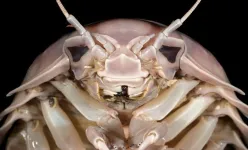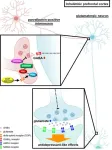(Press-News.org) Cigarette smoking is widespread and deadly, yet our understanding of how cigarette smoke actually causes serious respiratory illnesses is incomplete, which has severely hampered the development of effective treatments. Today (TBC) Australian researchers reveal how multiple chemicals found in cigarette smoke and e-cigarettes alter the function of a key type of immune cell found in the lungs.
The study, published in the Journal of Experimental Medicine (JEM), suggests that these alterations make cigarette smokers, and those exposed to second- and third-hand smoke, more susceptible to respiratory infections, and worsen smoking-related inflammatory diseases such as chronic obstructive pulmonary disease (COPD).
Cigarette smoking is known to impair the immune system’s response to infections and promote inflammation in the lungs that can lead to or exacerbate COPD, the third leading cause of death worldwide. COPD patients are more susceptible to influenza infections that can, in turn, worsen the underlying disease by increasing airway inflammation and promoting the destruction of the lung’s air sacs. There are currently no effective treatments for COPD.
According to Dr Wael Awad, from Monash University’s Biomedicine Discovery Institute, first author on the new JEM study, “until now the mechanisms underlying the skewed immune responses in people exposed to cigarette smoke, and how they are related to smoke-associated diseases like COPD remain unclear.”
Professor Jamie Rossjohn of Monash University’s Biomedicine Discovery Institute co-led the study with Professor David P. Fairlie of the Institute for Molecular Bioscience at University of Queensland, Professor Alexandra J. Corbett of the University of Melbourne, based at the Peter Doherty Institute for Infection and Immunity, and Professor Philip M. Hansbro of the Centenary Institute and University of Technology Sydney.
In their study, the researchers looked at the effects of cigarette smoke on Mucosal-Associated Invariant T (MAIT) cells, a type of immune cell found in the lungs and other tissues of the body. MAIT cells help fight off bacterial and viral infections and can promote inflammation or tissue repair.
MAIT cells are activated by a protein called MR1 that is found in almost every cell of the body. MR1 recognises chemicals produced by bacteria and presents them at the surface of infected cells in order to activate MAIT cells and initiate an immune response. “While we know that smoke from cigarettes, bushfires, cooking, vehicle exhausts and burning waste pose significant health risks, we still surprisingly know relatively little about how the specific components pf smoke affect our immune system and how they impact multiple parts of the human body,” Professor Fairlie said.
“We suspected that some of the more than 20,000 chemicals present in cigarette smoke that smokers inhale might also bind to MR1 and influence the activity of MAIT cells in the lungs”, Dr Awad said.
The researchers used computer modeling to predict which components of cigarette smoke might be recognised by MR1 and found that several of these molecules not only bound to the protein but also either increased or decreased in amounts on the surface of cells. These chemicals, including benzaldehyde derivatives that are also used as flavorings in cigarettes, e-cigarettes, blocked activation of human MAIT cells by compounds produced by bacteria.
The research team then studied the effects of cigarette smoke on MAIT cells from human blood and mice and showed they reduced MAIT cell function. Mice repeatedly exposed to cigarette smoke developed symptoms of lung disease and this was worsened if also infected by influenza. Researchers found that long-term exposure to cigarette smoke altered the protection provided to mice by their MAIT cells, making them less able to fight off influenza infections and more prone to the development of COPD disease.
“We found that mice lacking MAIT cells were also protected from cigarette smoke-induced COPD, showing reduced levels of lung inflammation and no tissue deterioration in their lung’s air sacs” Professor Hansbro said.
“This study demonstrates the power of collaboration and the insights we can gain with inter-disciplinary science,” Professor Corbett said.
“Overall, our study reveals that components of cigarette smoke can bind to the protein MR1 and reduce the functions of protective immune cells called MAIT cells. This increases susceptibility to infections worsens progression of lung disease” Dr Awad said. The researchers now plan to investigate exactly which MAIT cell pathways are impacted by cigarette smoke, in order to learn how to better treat COPD and other lung diseases.
END
Researchers discover how cigarette smoke impairs critical lung immune cells
How multiple chemicals in cigarette smoke & e-cigarettes alter the function of a key type of lung immune cell
2025-01-14
ELSE PRESS RELEASES FROM THIS DATE:
Commonly prescribed medications increase fall risk and related injuries in people with COPD
2025-01-14
Miami (January 14, 2025) – People with COPD experience more falls and related injuries requiring medical care when using common fall-risk increasing drugs, according to a new study. The study is published in the November 2024 issue of Chronic Obstructive Pulmonary Diseases: Journal of the COPD Foundation, a peer-reviewed, open-access journal.
Chronic obstructive pulmonary disease (COPD) is an inflammatory lung disease, comprising several conditions, including chronic bronchitis and emphysema. Symptoms include breathlessness, fatigue and chronic cough. The disease affects more than 30 million Americans and is the fourth leading ...
This metaphorical cat is both dead and alive – and it will help quantum engineers detect computing errors
2025-01-14
UNSW engineers have demonstrated a well-known quantum thought experiment in the real world. Their findings deliver a new and more robust way to perform quantum computations – and they have important implications for error correction, one of the biggest obstacles standing between them and a working quantum computer.
Quantum mechanics has puzzled scientists and philosophers for more than a century. One of the most famous quantum thought experiments is that of the “Schrödinger’s cat” – a cat whose life or death depends on the decay of a radioactive atom.
According to quantum mechanics, unless the atom is directly observed, ...
Digitizing hope: Collaboration helps preserve a species on the brink of extinction
2025-01-14
The vaquita, which means “little cow” in Spanish, is the world’s smallest porpoise and most endangered marine mammal. They also have the smallest range of any marine mammal; about 1,500 square miles within the northern Gulf of California. Since 1997, vaquitas have experienced a dramatic population loss from about 600 individuals to an estimate of less than 10 animals to date. At this current rate, vaquitas are expected to become extinct imminently.
The vaquita’s decline is caused by entanglement in illegal gillnets used to fish totoaba, an endangered species prized for its swim bladder. Despite a gillnet ban and conservation efforts, ...
The Dark Side of the ocean: New giant sea bug species named after Darth Vader
2025-01-14
Giant isopods of the genus Bathynomus, which can reach more than 30 cm in length, are known as bọ biển or “sea bugs” in Vietnam. For the first time, one such species was described from Vietnamese waters and named Bathynomus vaderi. The name “vaderi” is inspired by the appearance of its head, which closely resembles the distinctive and iconic helmet of Darth Vader, the most famous Sith Lord of Star Wars.
Bathynomus vaderi belongs to a group known as “supergiants,” reaching lengths of 32.5 cm and weighing over a kilogram. So far, this ...
Roman urbanites followed medical recommendations for weaning babies
2025-01-14
Babies were weaned earlier in cities in the Roman Empire than in smaller and more rural communities, according to a study of ancient teeth. Urban weaning patterns more closely hewed to guidelines from ancient Roman physicians, mirroring contemporary patterns of adherence to medical experts in urban and rural communities.
Roman health authorities recommended breastfeeding babies for two years. Carlo Cocozza and colleagues were interested in how ancient Romans actually fed their babies in varying settlement types. Carbon and nitrogen isotope ratios in dentine from the first permanent molars record ...
Strength connected to sexual behavior of women as well as men
2025-01-14
VANCOUVER, Wash. – While many studies have looked at possible evolutionary links between men’s strength and sexual behavior, a Washington State University study included data on women with a surprising result. Women, as well as men, who had greater upper body strength tended to have more lifetime sexual partners compared to their peers.
The study, published in the journal Evolution and Human Behavior, was designed to test evolutionary theories for human sexual dimorphism—namely that in early human history there was likely a reproductive advantage selecting for men’s greater upper body strength.
Another ...
Eating pork linked with better handgrip strength, vegetable intake in Korean older adults
2025-01-14
New research1 underscores the potential role of pork consumption in supporting dietary and muscle health in Korean older adults. Older adults are a nutritionally vulnerable population who often face unique challenges, including meeting daily protein and micronutrient requirements.
The study,* conducted through a collaborative partnership between researchers from Gachon University in South Korea, Tufts University, Think Healthy Group, LLC, and other leading institutions, suggests that pork consumption may be positively linked to nutrient intake, diet quality and handgrip strength—an indicator of overall muscle strength in older adults.
Using data from more than 2,000 ...
Direct discharge electrical pulses for carbon fiber recycling
2025-01-14
The world is hurtling rapidly towards a developed future, and carbon fiber-reinforced polymers (CFRPs) play a key role in enabling technological and industrial progress. These composite materials are lightweight and highly strong, making them desirable for applications in various fields, including aviation, aerospace, automotive, wind power generation, and sports equipment.
However, recycling CFRPs presents a significant challenge, with waste management being a pressing issue. Conventional recycling methods ...
Scientists uncover rapid-acting, low-side-effect antidepressant target
2025-01-14
The global burden of anxiety- and depression-related disorders is on the rise. While multiple drugs have been developed to treat these conditions, current medications have several limitations, including slow action and adverse effects with long-term use. This underscores the urgent need for novel, rapidly-acting therapeutic agents with minimal side effects.
The delta opioid receptor (DOP) plays a key role in mood regulation, making it a promising target for therapeutic intervention. Studies have shown that selective DOP agonists (compounds that activate DOP), such as SNC80 ...
Diamond continues to shine: new properties discovered in diamond semiconductors
2025-01-14
CLEVELAND and CHAMPAIGN-URBANA, ILL.—Diamond, often celebrated for its unmatched hardness and transparency, has emerged as an exceptional material for high-power electronics and next-generation quantum optics. Diamond can be engineered to be as electrically conductive as a metal, by introducing impurities such as the element boron.
Researchers from Case Western Reserve University and the University of Illinois Urbana-Champaign have now discovered another interesting property in diamonds with added boron, known as boron-doped diamonds. Their findings could pave the way for new types ...
LAST 30 PRESS RELEASES:
For teens, any cannabis use may have impact on emotional health, academic performance
School meals could unlock major gains for human and planetary health
Menopause hormone therapy does not appear to impact dementia risk
Signature patterns of brain activity may help predict recovery from traumatic brain injury
Dresden study uncovers new key mechanism in cancer cells
New species are now being discovered faster than ever before, study suggests
Cannabis-based products show limited short-term benefit for chronic pain, with increased risk of adverse effects
Cannabis products with more THC slightly reduce pain but cause more side effects
Clearing the brain of aging cells could aid epilepsy and reduce seizures
Brain injuries linked with potential risk of suicide, new study finds
New technique lights up where drugs go in the body, cell by cell
New study finds movement of fishing fleets can reveal shifts in marine ecosystems
Embargoed: New evidence points to potential treatment for vascular dementia
Study uncovers disrupted brain balance in alcohol dependence
Working in groups can help Republicans and Democrats agree on controversial content moderation online
Structural findings reveal how distinct GPCR ligands create different levels of activation
Anything-goes “anyons” may be at the root of surprising quantum experiments
UC review: Maximizing workplace opportunity for veterans
From generation to complex control: Metasurfaces make perfect vortex beams "within reach"
Thin-film lithium niobate-based detector: recent advances and perspectives
Exploring why some people may tend to persistently make bad choices
How cells balance their protein levels
Nirsevimab vs RSVpreF vaccine for RSV–related hospitalization in newborns
Effectiveness and impact of maternal RSV immunization and nirsevimab on medically attended RSV in US children
AI gives scientists a boost, but at the cost of too many mediocre papers
Next-generation vision model maps tree growth at sub-meter precision
Genes aren’t destiny for inherited blindness, study shows
MIT study: High-fat diets make liver cells more likely to become cancerous
Exposure to multiple fine particulate matter components and incident depression in the US Medicare population
Risk of burdensome health care spending over time in the US
[Press-News.org] Researchers discover how cigarette smoke impairs critical lung immune cellsHow multiple chemicals in cigarette smoke & e-cigarettes alter the function of a key type of lung immune cell
